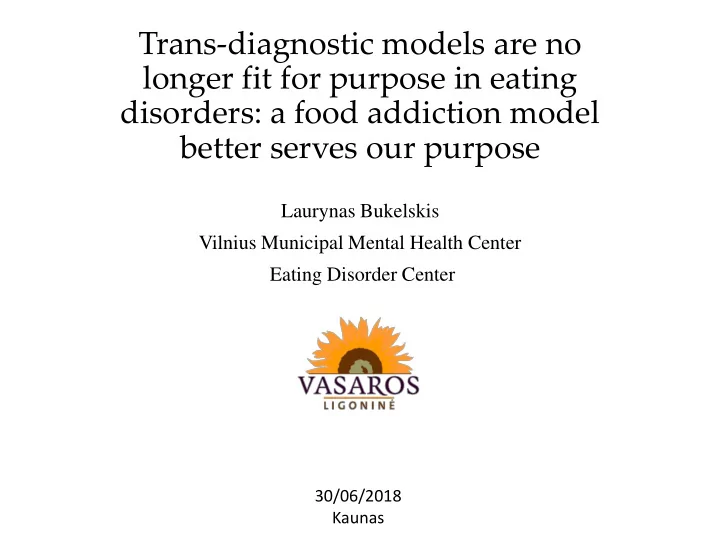

Trans-diagnostic models are no longer fit for purpose in eating disorders: a food addiction model better serves our purpose Laurynas Bukelskis Vilnius Municipal Mental Health Center Eating Disorder Center 30/06/2018 Kaunas
“We need players who are focused on football,” Germany Manager Joachim Low told Bild
Per capita consumption of hypothesized addictice food in the United states* Refined food addiction: A classic substance use disorder J.R. Ifland, H.G. Preuss, M.T. Marcus, K.M. Rourke, W.C. Taylor, K. Burau, W.S. Jacobs, W. Kadish, G. Manso. Medical Hypotheses 72 (2009) 518 – 526
Why do people in industrial societies persistently overeat despite considerable and repeated efforts not to do so? Why are 2/3 of the population of some western nations classified as overweight or obese despite the growing ‘ cult ’ of the thin body? Do you still blame only “negative emotions”?..
There is good evidence that carbohydrate preference (and likely fat preference and salt preference) is ‘hard - wired’ into humans because it plays a crucial role in attracting people to eat safe and nutritious foods such as fruits. Refined food addiction: A classic substance use disorder J.R. Ifland, H.G. Preuss, M.T. Marcus, K.M. Rourke, W.C. Taylor, K. Burau, W.S. Jacobs, W. Kadish, G. Manso. Medical Hypotheses 72 (2009) 518 – 526
Some people may experience abnormal activity in brain reward circuits in response to food and eating, predisposing them to energy imbalance and obesity. This is similar to individuals with SUDs , who show increased activity in these circuits in response to psychoactive drugs (Dawe & Loxton, 2004). Moreover, it is the manner in which the food is presented (i.e., intermittently) and consumed (i.e., repeated, intermittent ‘‘gorging’’) that appears to encourage the addiction-like process (1) 1. Rebecca L. Corwin and Patricia S. Grigson, Symposium Overview — Food Addiction: Fact or Fiction?. The Journal of Nutrition, 2009.
The picture that is emerging is that obesity, similar to drug addiction, appears to result from imbalanced processing in a range of regions implicated in • reward/saliency, • motivation/drive, • emotion/stress • reactivity, • memory/conditioning, • executive function/self-control • interoception Carnell S, Gibson C, Benson L, Ochner CN, Geliebter A. Neuroimaging and obesity: current knowledge and future directions. Obes Rev 2011; 13 : 43 – 56.
The current transdiagnostic model of ED ignores the reality of addiction and addiction processes – therefore current treatments for BN and BED are not sufficiently effective.
BUT… YES! Is the food addictive? - Only certain food (high GI, high sugar and fat combinations); - The manner in which the food is presented matters; - Although main mechanisms overlap, there are some differences with SUD; - Should we look for another name to avoid stigmatisation?
Thank you
Recommend
More recommend